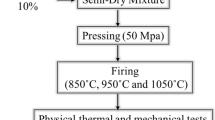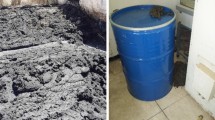Abstract
The marble industry generates enormous amounts of waste every year, whose incorrect management can lead to environmental problems. The Circular Economy model can provide an effective solution to this issue, an aspect that has been addressed in this research. The suitability of a marble sludge generated in the ornamental rock industry of Andalusia (Spain) has been assessed as raw material in ceramic bricks. Mixtures containing a clayey base and 0, 2.5, 5, 7.5, and 10 wt% of marble powder have been shaped into 60 × 30 × 10-mm3 prismatic specimens and sintered at 950 °C in a muffle. The main technological properties of the bricks related to color, shrinkage, porosity, water absorption, suction, and compressive strength have been determined. The addition of marble sludge has fostered the development of a lighter color, together with a significant increase of the open porosity. This aspect has implied, on the one hand, higher water absorption and suction results and, on the other hand, a decrease of the density and the mechanical strength. The correlations obtained after applying Shapiro-Wilk normality tests and r Pearson coefficients endorse the clear relationship between the addition of marble powder and the abovementioned effects on the technological properties of the sintered bricks. All the measured properties fully meet the brick standardized requirements, which would indicate that the recycling of marble wastes could be a promising alternative to obtain eco-friendly lightweight ceramic materials.








Similar content being viewed by others
References
Acchar W, Vieira FA, Hotza D (2006) Effect of marble and granite sludge in clay materials. Mater Sci Eng A 419:306–309. https://doi.org/10.1016/j.msea.2006.01.021
Alyamaç KE, Tuğrul E (2014) A durable, eco-friendly and aesthetic concrete work: marble concrete. 11th International Congress on Advances in Civil Engineering (ACE 2014) 50:21–25
ASTM D 4318-10e1 (2014) Standard Test Methods for Liquid Limit, Plastic Limit, and Plasticity Index of Soils. Annual Book of ASTM Standards, ASTM International, West Conshohocken
ASTM-C373-18 (2018) Standard test methods for determination of water absorption and associated properties by vacuum method for pressed ceramic tiles and glass tiles and boil method for extruded ceramic tiles and non-tile fired ceramic Whiteware products. American Society for Testing and Materials
Cerdá E, Khalilova A (2016) Economía Circular. Econ Ind 401:11–20 ISSN 0422-2784
Dhanapandian S, Gnanavel B (2009) An investigation on the effect of incorporation of granite and marble wastes in the production of bricks. ARPN J Eng Appl Sci 4(9):46–53
Dhanapandian S, Gnanavel B, Ramkumar T (2009) Utilization of granite and marble sawing powder wastes as brick materials. Carpathian J Earth and Environ Sci 4(2):147–160
EN 772–1:2011+A1:2015 (2011) Methods of test for masonry units - Part 1: Determination of compressive strength. European Committee for Standardization
EN 772–11:2011 (2011) Methods of test for masonry units - part 11: determination of water absorption of aggregate concrete, autoclaved aerated concrete, manufactured stone and natural stone masonry units due to capillary action and the initial rate of water absorption of clay masonry units. European Committee for Standardization
EN 772–13:2000 (2000) Methods of test for masonry units - part 13: determination of net and gross dry density of masonry units (except for natural stone). European Committee for Standardization
EN 772–16:2011 (2011) Methods of test for masonry units - part 16: determination of dimensions. European Committee for Standardization
EN 772–21:2011 (2011) Methods of test for masonry units - part 21: determination of water absorption of clay and calcium silicate masonry units by cold water absorption. European Committee for Standardization
Fiori C, Fabbri B, Donati G, Venturi I (1989) Mineralogical composition of the clay bodies used in the Italian tile industry. Appl Clay Sci 4(5–6):461–473. https://doi.org/10.1016/0169-1317(89)90023-9
Földvári M (2011) Handbook of thermogravimetric system of minerals and its use in geological practice. Occasional papers of the geological Institute of Hungary. Geological Institute of Hungary. Volume 213. ISBN 978–963–671-288-4
García-Ten J, Orts MJ, Saburit A, Silva G (2010) Thermal conductivity of traditional ceramics. Part I: influence of bulk density and firing temperature. Ceram Int 36(6):1951–1959. https://doi.org/10.1016/j.ceramint.2010.05.012
Jackson ML (1969) Soil chemical analysis – advanced course, 2nd edn. University of Wisconsin, Madison, p 895
Martínez C, Cotes T, Corpas FA (2012) Recovering wastes from the paper industry: development of ceramic materials. Fuel processing technology. Fuel Process Technol 103:117–124. https://doi.org/10.1016/j.fuproc.2011.10.017
Martínez C, Cotes T, Corpas FA, Iglesias FJ (2014) Porosity of expanded clay manufactured with addition of sludge from the brewing industry. Int J Energy Environ Eng 5:341–347. https://doi.org/10.1007/s40095-014-0112-6
Mekki H, Anderson M, Benzina M, Ammar E (2008) Valorization of olive mill wastewater by its incorporation in building bricks. J Hazard Mater 158:308–315. https://doi.org/10.1016/j.jhazmat.2008.01.104
Menezes RR, Ferreira HS, Neves GA, Lira HL, Ferreira HC (2005) Use of granite sawing wastes in the production of ceramic bricks and tiles. J Eur Ceram Soc 25(7):1149–1158. https://doi.org/10.1016/j.jeurceramsoc.2004.04.020
Moreno-Maroto JM, Alonso-Azcárate J (2017) Plastic limit and other consistency parameters by a bending method and interpretation of plasticity classification in soils. Geotech Test J 40(3):467–482. https://doi.org/10.1520/GTJ20160059
Moreno-Maroto JM, Alonso-Azcárate J (2018) What is clay? A new definition of “clay” based on plasticity and its impact on the most widespread soil classification systems. Appl Clay Sci 161:57–63. https://doi.org/10.1016/j.clay.2018.04.011
Segadães AM, Carvalho MA, Acchar W (2005) Using marble and granite rejects to enhance the processing of clay products. Appl Clay Sci 30:42–52. https://doi.org/10.1016/j.clay.2005.03.004
Steffen W, Richardson K, Rockström J, Cornell SE, Fetzer I, Bennett EM, Biggs R, Carpenter SR, De Vries W, De Wit CA, Folke C, Gerten D, Heinke J, Mace GM, Persson LM, Ramanathan V, Reyers B, Sörlin S (2015) Planetary boundaries: guiding human development on a changing planet. Science 347(6223):1259855. https://doi.org/10.1126/science.1259855
Torres P, Fernandes HR, Agathopoulos S, Tulyaganov DU, Ferreira JMF (2004) Incorporation of granite cutting sludge in industrial porcelain tile formulations. J Eur Ceram Soc 24(10–11):3177–3185. https://doi.org/10.1016/j.jeurceramsoc.2003.10.039
Torres P, Fernandes HR, Olhero S, Ferreira JMF (2009) Incorporation of wastes from granite rock cutting and polishing industries to produce roof tiles. J Eur Ceram Soc 29(1):23–30. https://doi.org/10.1016/j.jeurceramsoc.2008.05.045
Trio Maseda M, Ortuño MG (2017) Panorama Minero 2016, Instituto Geológico y Minero de España, Madrid, España
Tunç ET (2018) The effects of cement dosage on the mechanical properties of concrete produced with waste marble aggregate. 13th Int. Cong. On Adv. Civ Eng (ACE 2018), 12–14
Tunc ET (2019) Recycling of marble waste: a review based on strength of concrete containing marble waste. J Environ Manag 231:86–97. https://doi.org/10.1016/j.jenvman.2018.10.034
Tunç ET, Alyamaç KE (2018) Use of waste marble: architectural concrete. International conference on innovative engineering applications (CIEA, 2018) Pag 586–594
UNE 103-200-93 (1993) Determinación del contenido de carbonatos en los suelos. Asociación Española de Normalización
Vieira CMF, Soares TM, Sánchez R, Monteiro SN (2004) Incorporation of granite waste in red ceramics. Mater Sci Eng A 373:115–121. https://doi.org/10.1016/j.msea.2003.12.038
Webster K (2017) The circular economy: a wealth of flows, 2a edn. Ellen MacArthur Foundation Publishing
Acknowledgments
The technical and human support provided by CICT of Universidad de Jaén (UJA, MINECO, Junta de Andalucía, FEDER) is gratefully acknowledged.
Funding
This work has been funded by the SMARTMATS Project, (MAT2015-70034-R, Spanish Ministry of Economy and Competitiveness).
Author information
Authors and Affiliations
Corresponding author
Additional information
Responsible editor: Philippe Garrigues
Publisher’s note
Springer Nature remains neutral with regard to jurisdictional claims in published maps and institutional affiliations.
Rights and permissions
About this article
Cite this article
Cobo-Ceacero, C.J., Cotes-Palomino, M.T., Martínez-García, C. et al. Use of marble sludge waste in the manufacture of eco-friendly materials: applying the principles of the Circular Economy. Environ Sci Pollut Res 26, 35399–35410 (2019). https://doi.org/10.1007/s11356-019-05098-x
Received:
Accepted:
Published:
Issue Date:
DOI: https://doi.org/10.1007/s11356-019-05098-x




